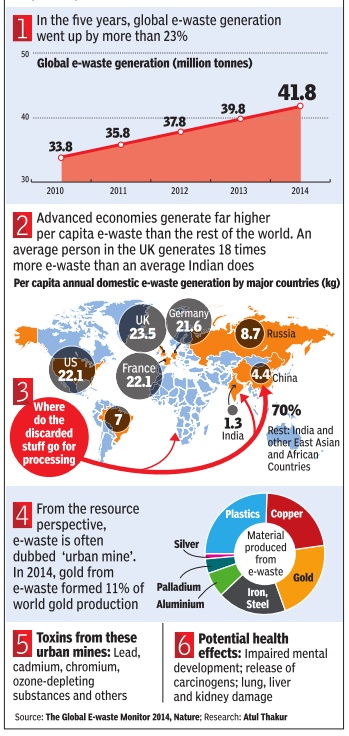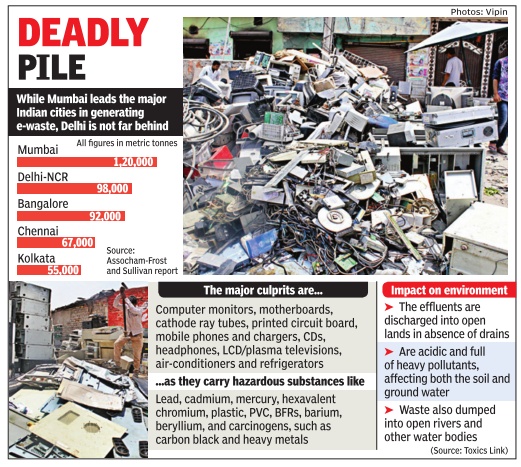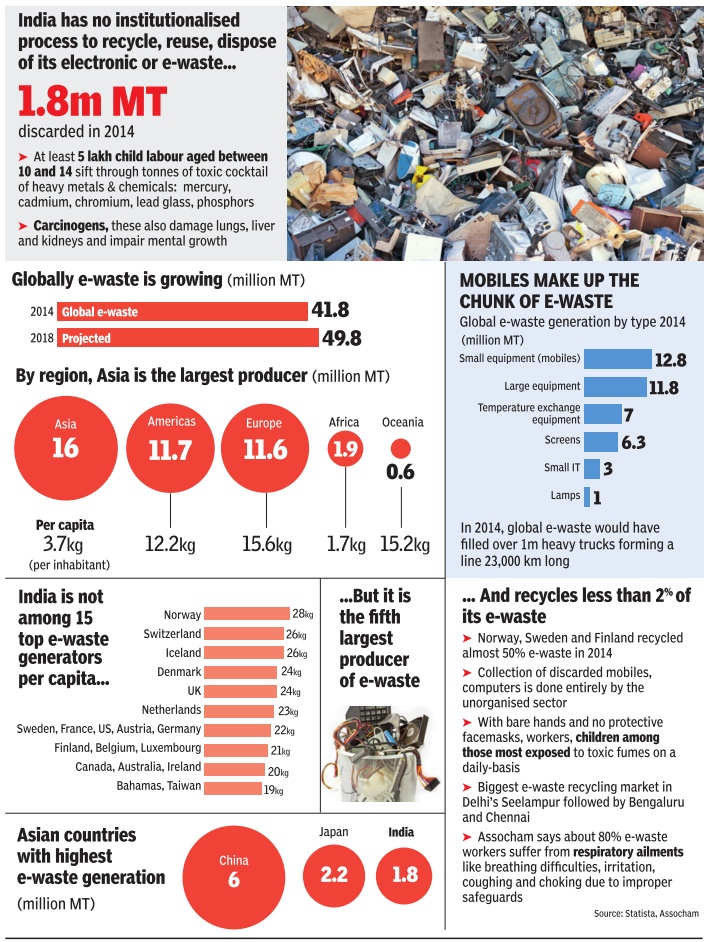E-waste, electronic waste: India
This is a collection of articles archived for the excellence of their content. |
Contents |
The extent of the problem
2010-14

See graphic:
Global e-waste generation, 2010-14
2014: India 5th biggest generator
The Times of India, Apr 20 2015
India 5th biggest generator of e-waste in 2014: UN report
India is the fifth biggest producer of ewaste in the world, discarding 1.7 million tonnes (Mt) of electronic and electrical equipment in 2014, a UN report has said warning that the volume of global e-waste is likely to rise sharply by 21% in next three years.
The `Global E-Waste Monitor 2014', compiled by UN think tank United Nations University (UNU), said at 32%, the US and China produced the most e-waste overall in 2014. India came in fifth, behind the US, China, Japan and Germany , the report said. Most e-waste in the world in 2014 was generated in Asia at 16 Mt or 3.7kg per inhabitant. The top three Asian nations with the highest e-waste generation in absolute quantities are China (6.0Mt), Japan (2.2Mt) and India (1.7Mt).
The top per capita producers by far are the wealthy nations of northern and western Europe, the top five being Norway , Switzerland, Iceland, Denmark, and the UK. The lowest amount of ewaste per inhabitant was generated in Africa (1.7kg inhabitant). The continent generated 1.9Mt of e-waste in total. In 2014, people worldwide discarded all but a small fraction of an estimated 41.8Mt of electrical and electronic equipment -mostly end-of-life kitchen, laundry and bathroom equipment like microwave ovens, washing machines and dishwashers.
The volume of e-waste is expected to rise by 21% to 50Mt in 2018, said the report, which details the location and composition of the world's fast-growing e-waste problem.
2015-16
The Times of India, May 11 2016

See graphic : Electronic waste, a menace, India and the world, 2015-18 (projected)

E-waste poses heavy metal threat
Jasjeev Gandhiok The ministry of environment, forest and climate change recently redesignated the electronic waste disposal business as a red-category industry . According to the ministry , red-category industries pose the biggest threat to the environment because they generate the highest pollution load in the sector.
This re-categorisation, however, has not stopped the illegal e-waste disposal sites in Delhi from operating without licenses or proper protection.TOI visited two such sites in Seelampur and Shastri Park and the conditions at both locations were appalling. In Seelampur, for example, tonnes of discarded electronics are manually dismantled each day .Not only does the extraction process here pose a health risk to the workers and the environment, but no safety measures are taken while disposing of the e-waste either.
The waste was handled on open grounds and broken down manually to extract recyclable metals to be resold, leaving both the workers and soil exposed to toxic materials like lead, cadmium, mercury and the acid fumes generated in the process. According to experts, prolonged exposure to these can cause nausea, irritability, headaches, and li ver and kidney problems in the long run.
“There is no disposal system at these places, and the waste is eventually dumped into the Yamuna,“ said Piyush Mohapatra of Toxics Link, an environmental NGO.With the business being slotted in the red category and with new rules to be implemented soon, Mohapatra hopes that the safer, formal ewaste processing sector will begin to dominate.
Child labourers are a common sight at the illegal extraction sites. A report released by Assocham-Frost & Sullivan on World Earth Day pointed out that five lakh children between the ages of 10 and 14 were engaged in e-waste processing activities.
Discarded electronic items are procured illegally through unofficial channels by these operators since they aren't authorised to collect or dispose of e-waste. “The waste comes from distance places, even from outside Delhi,“ admitted a labourer who did not wished to be named. “We have been trying to get a licence for long time, but with that not happening we get e-garbage from local dumps too.“
These labourers also claim the Delhi Pollution Control Committee knows about their existence. “We tried getting a licence from them but were told to acquire land first,“ the labourer added.“Since it is difficult for many of us to set things up properly , we continue on a small scale like this.“
2017: India generated 2m. out of world’s 44.7m. tonnes e- waste
If the per capita generation of e-waste is taken into account individually, every person on the planet at present is responsible for generating 6kg of e-waste annually. About 80% (4.8kg) of this either ends up in landfills or is informally recycled, exposing workers to hazardous and carcinogenic substances and contaminating soil, ground water and food supply system.
This alarming fact was flagged by seven UN agencies on the sidelines of World Economic Forum at Davos on Thursday, urging the world for an overhaul of the current system of disposing and recycling of such waste so that it can minimise environmental impacts and create decent, sustainable jobs.
Calling the quantum, being generated globally, a “tsunami of e-waste”, the UN entities said the world produced as much as 50 million tonnes of electronic and electrical waste (e-waste) a year, weighing more than all of the commercial airliners ever made.
Noting that only 20% of the total e-waste is formally recycled, their report warned that the global ewaste production was on track to reach 120 million tonnes per year by 2050 if the current trends continued.
Figures from 2016, compiled as the ‘Global E-Waste Monitor 2017’ by the United Nations University, show that India generated 2 million (20 lakh) tonnes of e-waste out of total 44.7 million tonnes of e- waste globally that year.
India has a capacity to dismantle and recycle only 20% (over 4 lakh tonnes) of its total e-waste. Though there is no comprehensive state-wise inventorisation of e-waste generation in India, the country has a total 178 dismantler and recycling units with highest number of such units (57) being in Karnataka followed by Maharashtra (32), UP (22), Haryana (16) and Tamil Nadu (14).
Asked about India, Gopal Krishna of the Toxic Watch Alliance, said, “The threat to public health from e-waste is enormous as environmental and occupational health infrastructure is almost nonexistent in the country.”
The rules on e-waste management in India mandates producers to be responsible for the collection and financing of systems through Extended Producer Responsibility (EPR) concept. Krishna said, “Although e-waste management rules introduced EPR, it remains inadequate.”
2018: South Asia in Bottom 5, per capita

From: February 7, 2019: The Times of India
See graphic:
In 2018, India, Afghanistan and Nepal were among the Bottom 5 countries that generated E-waste in per capita terms
2018-19
January 26, 2019: The Times of India

From: January 26, 2019: The Times of India
See graphic:
E-waste, as in 2018-19.
Have you wondered what happens to your old smartphone when you upgrade? Chances are it will eventually end up in a landfill, part of the mounting mass of e-waste that is now the fastest-growing waste stream in the world. Discarded electronics also contain precious metals and rare materials. As it keeps piling up, UN warns of a “tsunami of e-waste” that humans ignore to their own loss and at their own peril.
2016-20
Vishwa Mohan, Dec 3, 2022: The Times of India

states that recycle the most waste with the processing capacity
From: Vishwa Mohan, Dec 3, 2022: The Times of India

From: Chittaranjan Tembhekar, Dec 3, 2022: The Times of India
The collection and disposal of electronic waste (e-waste) is a global challenge, and in India – the third largest generator of such waste – nearly 78% is not collected. As a result, extremely valuable secondary raw materials in the waste, including gold, silver, copper and many rare earth elements, end up in landfills or lie unused with consumers.
The UN-backed Global Ewaste Monitor estimated that the e-waste generated around the world in 2019 contained raw materials (mainly iron, copper and gold) worth $57 billion. Consequently, it described e-waste as an ‘urban mine’ because the critical and non-critical metals in it can be recycled as secondary raw materials.
The Monitor said India generated 32 lakh tonnes** (LT) of e-waste in 2019, while the Ficci Circular Economy Report for 2017 said the country could have extracted gold worth $0. 7-1 billion from e-waste.
Recognising the importance of recycling, Government of India has authorised as many as 472 dismantlers/recyclers with a processing capacity of over 14. 3 LT.
However, most recyclers have not utilised even 50% of their licensed capacity in the past few years. In 2019-20 India generated 10. 1 LT of e-waste but only 22% of it was processed.
Need To Increase Collection
Globally, the situation is no better. Only 17. 4% of e-waste was documented as formally collected and recycled in 2019 even though many developed countries have e-waste recycling rates of 50-70%. The Monitor estimates global ewaste generation to touch 747 LT per year by 2030.
The lack of a dedicated and robust e-waste collection chain in India is a major bottleneck for recycling, Prof Nikhil Dhawan of IIT Roorkee, told TOI. As a result, “Recycling is predominantly carried out by the informal sector employing manual dismantling, open burning, melting, and uncontrolled leaching. ” Dhawan stressed on the need for investments in “e-waste management systems to promote environment-friendly and sustainable metal recovery processes”.
An Ecological Imperative
Beyond its economic value, recycling can shield living beings and the environment from toxic substances, such as brominated flame retardants (BFR) and chlorofluorocarbons (CFCs), found in many electronic devices.
Government measures to increase collection and recycling improved e-waste processing in India from 10% of the total waste in 2017-18 to 22% in 2019-20, but the sector continues to be plagued by the lack of facilities.
“India has very limited capacity for large-scale management of e-waste. Governmentcentres process only about a fifth of the e-waste generated each year as there is practically no mechanism for collection in this labour-intensive sector,” said Ashish Agarwal, secretary, Recycle India Foundation. As e-waste recycling with primitive methods can damage the environment, the recycling infrastructure should be improved and manufacturers encouraged to set up e-waste drop points, Agarwal said, adding that consumers should also get incentives for disposing of their devices properly.
Govt Offering Incentives
On their part, different ministries have taken steps to formalise the e-waste recycling sector through E-waste (Management) Rules, 2016, and the amended Scheme for Promotion of Manufacturing of Electronic Components and Semiconductors (SPECS). The scheme provides a financial incentive of 25% on capital expenditure for setting up modern recycling facilities for the extraction of precious metals from e-waste.
Under the 2016 rules, the principle of extended producer responsibility (EPR) has been implemented for e-waste management. Producers have to collect targeted quantities of ewaste that’s processed by authorised dismantlers and recyclers per Central Pollution Control Board (CPCB) guidelines. Aselectronic and electrical equipment (EEE) is a high-growth area, proper implementation of these rules is the only way to procure secondary raw materials in a cost-effective and environmentfriendly manner.
A policy paper of the Ministry of Electronics and Information Technology on circular economy (CE) in the EEE sector says e-waste mining offers an opportunity to secure the supply of resources needed for manufacturing EEE products, solar panels, electric vehicles, and hightech defence equipment:
“Lack of domestic reserves and supply of rare earth elements makes a circular economy even more important for a large and growing country where a CE approach provides an opportunity to enhance resource availability for domestic manufacturing. ”
Details
Chittaranjan Tembhekar, Dec 3, 2022: The Times of India
India is the world’s third largest ewaste producer now behind China and the US. Unsurprisingly, the country’s wealthiest city, Mumbai, is a big contributor to the rising pile of discarded gadgets. It could lead the way with e-waste collection and recycling best practices, but as things stand it is far from being a role model.
At junkyards in Deonar and Andheri, hundreds of dealers like Roshan Sharif separate Mumbai’s e-waste from other scrap in a cumbersome and labour-intensive way, risking their own health and polluting the environment.
It’s not their fault though. Mumbai’s municipal corporation, BMC, says a very large number of residents dispose of their e-waste with garbage, which is how it reaches the ragpickers, and then the traditional scrap dealers.
The corporation recently did a survey and found that about 8 lakh buildings do not segregate waste at all, S B Nanote, executive engineer with BMC’s e-waste wing, told TOI. Ramesh Prabhu of the Maharashtra Societies Welfare Association said residents throw away e-waste with other garbage because housing societies are not penalised for not segregating waste by type.
Mountain Of Waste
Central Pollution Control Board (CPCB) data shows a steep rise in India’s yearly e-waste generation. From 7. 7 lakh tonnes in 2018-19, it jumped to 10. 1** lakh tonnes in 2019-20 – a growth of 31%. Maharashtra contributes around 8% of India’s e-waste now, and Mumbai alone accounts for 5%.
Besides the e-waste generated within the country, large quantities are imported for recycling. A significant share of this waste ends up at the more than 470 authorised dismantlers and recyclers spread over 22 states and having a combined processing capacity of more than 14 lakh tonnes.
Within Maharashtra there are 103 dismantlers and 44 recyclers, and BMC sources say Mumbai city itself can handle around 3,760 metric tonnes of e-waste annually. But the issue is, only 300 MT e-waste reaches these facilities even though around 21 lakh buildings in Mumbai dispose of their e-waste separately. This is because a sizeable chunk of e-waste goes to kabadiwalas. B K Soni, chairman and managing director of Eco Recycling Ltd, said lack of awareness among people leads to unscientific e-waste disposal. So, even though e-waste-specific collectors like ‘Book My Junk’ are around, people hand over their e-waste to the kabadiwala.
Huge Appliance Heap
It’s interesting that only 16% of India’s e-waste comes from households. Nearly 75% is generated by the government, the public sector and the private sector. Overall, computers and peripherals account for about 70% of e-waste, 12% comes from the telecom sector, 8% from medical equipment and 7% from electrical equipment. In Maharashtra, though, refrigerators are the biggest component of the e-waste generated by weight, followed by personal computers, TV sets and washing machines. Last year, about 18,560 tonnes of e-waste was dismantled in Maharashtra.
Illegal recycling
The Times of India, May 11 2016
95% of e-garbage heads to illegal dealers
Jasjeev Gandhiok India generates 18.5 lakh metric tonnes of electronic waste each year, with Delhi (98,000 MT) second on the list after Mumbai (1.2 lakh MT) as the biggest contributor. Proper disposal of e-waste is important because of hazards posed to health by the materials used in electronics, but almost a third of the disused electronic items are not reaching the authorised ewaste collectors in the capital.
“Most consumers give away their e-waste to a scrap dealer, who sends it to illegal processing centres,“ said Lalan Shah, owner of Krishna Trading, an authorised e-waste collector in Mayapuri. Because improper disposal of ewaste can release lead, mercury, heavy metals, carcinogens and dioxins into the environment, Delhi Pollution Control Committee issues a licence to collectors who have the wherewithal to deal with these. Legal processors recycle or retrieve valuables from the waste while getting rid of the residue in a safe manner.
Household electronics account for 75% of all e-waste generated, but most people are unaware of whom to approach to discard the old mobile phones, computers, laptops and other electronic devices.So a few collection companies are now looking at means to attract such households. Pom Pom Recycling Ltd, for instance, has released an app and also takes orders to help people get rid of unwanted electronics, while paying them for providing recyclable materials.
“At Pom Pom, we are try ing to create a solution for people to ensure their e-waste goes to government-approved recyclers. An app makes things more convenient,“ said Deepak Sethi, founder of Pom Pom Recycling. But it is a tough battle, fi nancially and operationally , for legal processors because of the unscrupulous tactics adopted by unauthorised ewaste sites. “We collect e-waste only from Delhi, but many illegal centres are bringing them in from neighbouring states. This has affected our business to an extent,“ admitted the supervisor at an Okhla authorised e-waste centre.
Illegal e-waste firms channel 95% of all e-waste processed in the country , according to a recent study conducted by Assocham-Frost and Sullivan. They , thus, deprive the authorised firms of not only revenues, but also the chance to break down electronics without endangering the health of citizens.
Owners of the legal cent res hope for better times under the new rules on e-waste management coming into effect from October this year.Under them, electronics manufacturers will be made responsible for the collection of discarded devices. CFL bulbs and other mercury-containing devices will fall under the ambit.